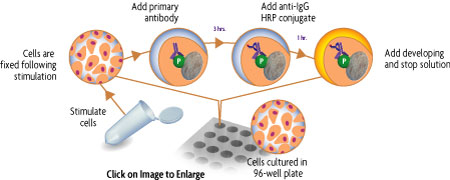THIS PRODUCT IS DISCONTINUED
Fast Activated Cell-based ELISA (FACE™) Kits provide a simple, sensitive method for detecting protein phosphorylation directly in the cell, without making extracts or performing electrophoresis and membrane blotting. These 96-well, high-throughput assays are available in both colorimetric and chemiluminescent formats for over 20 different targets (see list at right). For complete details, click the FACE™ Method tab below.
FACE ERK1/2 Kits provide 96 rxns each of 2 antibodies that enable you to monitor and compare the levels of both phosphorylated and total ERK1/2. The phospho-ERK antibody recognizes ERK1 when phosphorylated at Thr202 and Tyr204, as well as ERK2 when phosphorylated at Thr185 and Tyr187; the total-ERK antibody recognizes ERK1 and ERK2 proteins regardless of their phosphorylation states. Click the ERK1/2 Info tab below for data and more information.
| Name | Format | Cat No. | Price | |
|---|---|---|---|---|
| FACE™ ERK1/2 | 1 x 96 rxns | 48140 | Discontinued | |
| 5 x 96 rxns | 48640 | Discontinued | ||
| FACE™ ERK1/2 Chemi | 1 x 96 rxns | 48240 | Discontinued | |
| 5 x 96 rxns | 48740 | Discontinued | ||
| FACE™ ERK1/2 Manual |
| FACE™ Profile |
| Cell Biology Products Brochure |
| IsoCyte™ Application Note – Phospho-Protein Detection |
| MSDS: Sodium Azide |
| MSDS: Sulphuric Acid |
| MSDS: Thimersol |

Figure 1: Colorimetric measurement of phosphorylated ERK and total ERK.Murine Macrophage 4/4 cells were cultured in 96-well plates and serum-starved for 16 hours. Cells were then stimulated with the indicated amounts of Phorbol 12-myristate 13-acetate (PMA) for 10 minutes and fixed. Total ERK and phospho ERK were each assayed in triplicate using the phospho-ERK and total-ERK antibodies included in the FACE ERK1/2 Kit. Data was plotted after correction for cell number (performed through use of Crystal Violet). Note that the induction treatment did not affect the overall level of total ERK.
Antibody Specificities
The phospho-ERK antibody is specific for phosphorylated ERK1 and ERK2 and was raised against a synthetic phospho-peptide corresponding to residues Thr202 and Tyr204 of human ERK1 and Thr185 and Tyr187 of human ERK2. This antibody recognizes both phosphorylated ERK1 and ERK2. It does not recognize unphosphorylated ERK1 or ERK2, nor does it recognize other phosphorylated proteins. The total-ERK antibody recognizes ERK1 and ERK2 regardless of the phosphorylation state.
ERK1/2 Overview
The extracellular signal-regulated kinases 1 and 2 (ERK1 and ERK2), also called p44 and p42 MAP kinases, are members of the Mitogen Activated Protein Kinase (MAPK) family of proteins found in all eukaryotes. Because the 44 kDa ERK1 and the 42 kDa ERK2 are highly homologous and both function in the same protein kinase cascade, the two proteins are often referred to collectively as ERK1/2 or p44/p42 MAP kinase. The ERK1/2 signaling cascade has been shown to be a critical regulator of cell differentiation, cell physiology and neuronal function. Aberrant control of ERK1/2 activity has been implicated in a variety of pathological conditions, including cancer and autoimmune diseases, and efficient study methods are in demand.
The FACE™ Method
In FACE, cells are cultured in 96-well plates and stimulated to induce the pathway of interest. Following stimulation, the cells are fixed rapidly, which preserves activation-specific protein modifications. Each well is then incubated with a primary antibody specific for the activated protein of interest. Subsequent incubation with secondary HRP-conjugated antibody and developing solution provides a colorimetric or chemiluminescent readout that is quantitative and reproducible (Figure 1). The number of cells in each well can be normalized easily with the provided Crystal Violet solution. FACE Kits also contain primary antibody specific for the native inactive protein, so you can monitor both native and activated protein levels in the same experiment. FACE eliminates cellular extractions, radioactive kinase assays, time-consuming Westerns and inefficient epitope interactions that occur on membranes. FACE is a highly sensitive high-throughput assay designed for detecting activated proteins within mammalian cells.
Figure 1: Flow chart of the FACE process.
Flow chart of the FACE in cell Western method that uses a cell based ELISA to measure the levels of the native and phospho forms of signaling proteins and kinases that are activated by phosphorylation.
Contents & Storage
Two (or ten) 96-well plates for culturing cells, 96 (or 5 x 96) rxns each of two primary antibodies (1 phospho-specific, 1 specific for native protein), HRP-conjugated secondary antibody, Quenching Solution, 1X Antibody Blocking Buffer, 1X Antibody Dilution Buffer, 10X PBS, 10% Triton X-100, 1% SDS Solution, Developing and Stop Solutions, and Crystal Violet Cell Quantification Solution. Storage conditions vary from room temperature to -20°C, see manual for details. All reagents are guaranteed stable for 6 months when stored properly.


